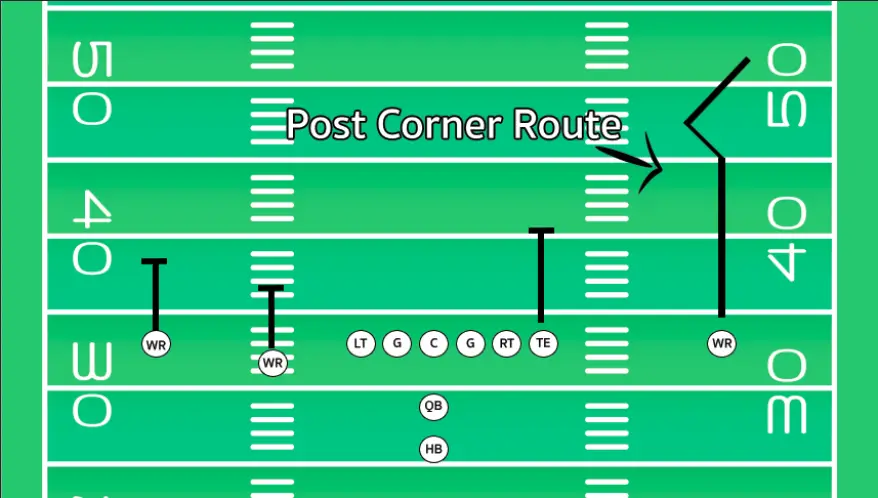A post corner route in football is a receiving pattern in which the receiver runs down straight down the field and then cuts fourty five degrees towards the middle of the field only to cut again back towards the corner of the endzone.
A post corner route is a combination of a post route and a corner route. On a post route, a receiver runs down the field then cuts towards the goalposts in the middle of the field.
With a corner route, the receiver runs straight down the field and cuts fourty five degrees towards the corner of the endzone. On the post corner route, the receiver is going to pretend he is running a post route only to quickly switch back to a corner route.
In football, a route like this can be referred to as a double move. Most receiving routes feature a single move like cutting towards the sideline.
A route that includes a double move is going to involve two separate cuts which are done in order to fool the defender. If the defender buys into the first move it will be much easier for the wide receiver to achieve separation from the defender.
What To Know About Post Corner Routes
Now that you understand what a post corner route is in football it is time to learn a little more about them. Below we will break down some key factors you should know about this receiving pattern.
A Post Corner Route Is A Homerun Play
One thing that you should know about post corner routes is that this plays are designed to go for a deep touchdown. This is the sort of route that is run maybe once or twice a game.
When a team decides to target a receiver running the post corner pattern they are looking to bust off a big play.
If you were to run this play over and over again throughout the game the defensive backs would start to catch on. This would make it much easier for them to react to the second cut of the route.
By saving up this route for when you need a big play you can hope to catch the defensive backfield off guard.
The Quarterback Will Need Time And Protection
Another key factor regarding this route is that it takes a long time to develop. As we said earlier most receiving routes only include a single cut. This means the quarterback needs to wait for that first cut. Then they can throw the ball towards the receiver.
On a post corner route, the receiver is going to make two cuts. Both of which occur relatively deep down the field.
This means the quarterback is going to need to avoid the defensive line and linebackers until the play develops.
Teams with poor pass protection are going to struggle to keep the quarterback protected for that period of time.
On some occasions, teams may bring in a tight end or running back to aid in pass protection on long developing plays that include post corner route.
Routes like a comeback or a slant are examples of receiving patterns that do not require much pass protection.
The Receiver Needs To Turn The Defensive Backs Hips
When it comes to post corner routes succeded with a post corner route one of the keys is making sure the defensive back turns his hips.
At the start of the play the cornerback or safety covering the receiver will be facing them somewhat head-on. Once the player makes a cut the defender will turn their hips and run whatever direction the receiver is running.
When it comes to the post corner route the receiver needs to get the defensive back to turn his hips on his first cut. If the db turns his hips to run a post route he will have to spin all the way around in order to cover the corner route.
This switching of the hips is what allows the receiver to generate separation. So long as the defender buys into the first cut faking the post the receiver should be able to get himself open downfield.

